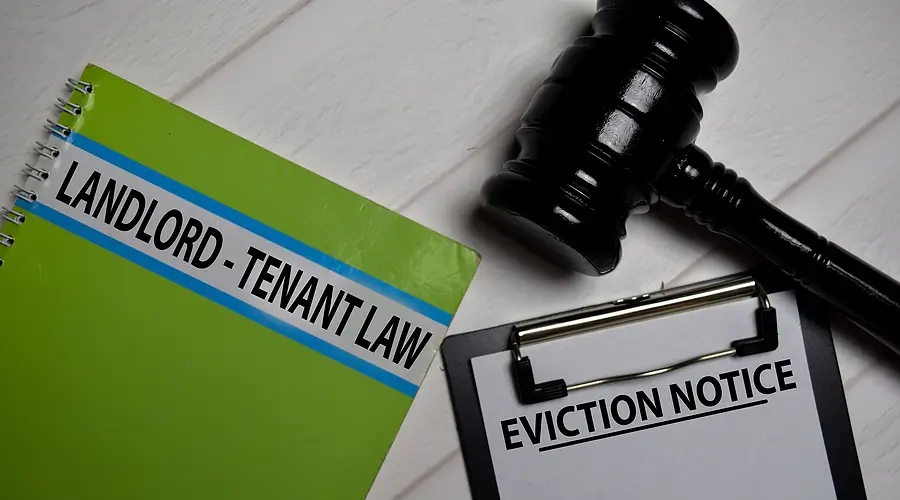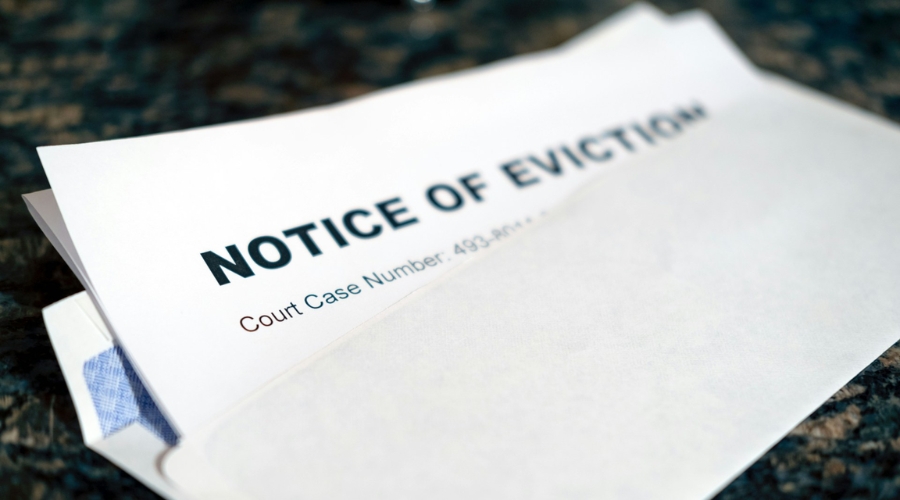Whether you're managing a rental property in Maine or expanding your portfolio to the West Coast, understanding the eviction process in California is essential. California has some of the most tenant-protective laws in the country, making legal compliance critical. From proper notice delivery to court filings, every step matters.
Looking to navigate the eviction process with confidence? LeaseRunner’s comprehensive guide walks you through each step, helping you avoid common pitfalls and safeguard your investment along the way.
Recent Legal Updates for California Eviction Laws (2025)
Landlords in California need to stay on top of changing housing laws, especially as new rules continue to shape the eviction process in California. Recent changes focus more on renters’ rights, clear procedures, and housing stability. Understanding these updates is key to managing the eviction process legally and smoothly.

Stricter No-Fault Eviction Rules & Relocation Assistance (SB 567)
Starting April 1, 2024, Senate Bill 567 sets stricter rules for landlords who want to evict tenants for no-fault reasons, like moving in themselves or doing major renovations. Landlords now need to give a clear reason and provide proof before moving forward.
Increased relocation compensation also comes into play under SB 567. When a tenant is removed on a no-fault basis, landlords must now offer enhanced financial aid to assist with moving costs. These provisions aim to reduce housing instability while ensuring fairness during the eviction process.
Renews AB 1482 Rent Cap & Exemptions
California continues to reinforce tenant protections through AB 1482, which imposes annual limits on rent increases for many residential properties.
California continues to protect tenants with AB 1482, which limits yearly rent increases. Rent can only go up by 5% plus local inflation, capped at 10% per year. Some properties are exempt, like those built in the past 15 years or owner-occupied duplexes.
AB 1482 establishes “Just-Cause” and sets clear rules for evictions. If a tenant has lived in a unit for 12 months or more, landlords must have a valid reason to evict them. These fall into two categories:
- At-fault just causes: These include nonpayment of rent, breach of lease, criminal activity, property damage, nuisance behavior, or refusal to sign a new lease after changes in tenancy.
- No-fault just causes: These cover scenarios such as owner move-in, removal of the unit from the rental market, government orders related to health/safety, or plans to demolish or substantially remodel the property.
Landlords must follow notice rules for no-fault evictions. AB 1482 doesn’t require relocation money unless local laws do.
These rent control rules are closely tied to the eviction process. If there's a dispute about rent hikes or an eviction notice, landlords need to understand how the laws work together to avoid legal trouble. Landlords must navigate these rules carefully to avoid legal pitfalls and protect tenant rights..
Local Emergency Protections
Some cities in California have their own rules to protect tenants during emergencies like natural disasters or unsafe living conditions. These rules add extra layers of protection beyond state law.
- Los Angeles Wildfire Relief: If renters in Los Angeles lose income due to wildfires, they may be protected from eviction. To qualify, tenants must show proof of their income loss. Landlords should review all documents carefully before giving any eviction notice.
- Hayward Tenant Relocation Ordinance: In Hayward, landlords must help cover moving costs when tenants are forced to leave through no fault of their own. This applies in cases like unsafe living conditions, big repairs, or when the building is being torn down.
-
- Temporary Relocation Help: If tenants must leave the home for short-term repairs (like fixing mold or structural problems), landlords must either waive one month’s rent or pay the same amount in cash. If the tenant has to stay away for a longer time, the landlord also needs to pay for reasonable moving and temporary housing costs.
-
- Permanent Relocation Help: If tenants are permanently displaced (like from demolition or major renovations), landlords must pay relocation fees. The amount depends on the size of the unit and who lives there — for example, seniors, people with disabilities, or low-income families may receive more help. These rules are meant to make sure tenants can find a new place without facing financial stress.
Valid Reasons for Eviction in California
Understanding the legal basis for removing a tenant is crucial for any landlord navigating the eviction process in California.
Under California eviction laws, a landlord cannot evict a tenant without a justifiable reason. These reasons are grouped into two main categories: fault-based evictions and no-fault evictions.

1. Failure to Pay Rent
Among the most frequently cited grounds in the eviction process in California is a tenant’s failure to pay rent.
When rent is overdue, landlords have the right to initiate action by serving a 3-Day Notice to Pay Rent or Quit. This notice provides the tenant with a short window to either bring the account up to date or vacate the premises.
If the tenant does not respond appropriately, the landlord may move forward with filing an unlawful detainer lawsuit, which is the legal pathway for eviction in California courts.
2. Lease Violations (Pets, Guests, Damage)
When tenants breach the terms of their lease, such as by keeping unauthorized pets, allowing unapproved long-term guests, or causing substantial damage to the property, landlords may issue a 3-Day Notice to Cure or Quit. This notice provides the tenant a chance to fix the issue, such as removing the pet or repairing damage.
In cases where the violation continues or is repeated, landlords may proceed with eviction. These types of violations often fall under at-fault reasons, a key element in the eviction process in California, particularly when the rental agreement clearly outlines behavioral expectations.
3. Illegal activity on premises
Engaging in criminal behavior within the rental unit is considered a serious breach. Activities such as drug manufacturing, violence, or other offenses that threaten the safety of neighbors or the integrity of the property provide grounds for immediate eviction. Landlords can serve an Unconditional 3-Day Notice to Quit, which does not allow the tenant to correct the behavior.
4. Owner Move-In or Renovation (No-Fault Eviction)
Landlords can sometimes evict tenants even when the tenant hasn’t done anything wrong. These are known as no-fault evictions, and they are legal in California under certain conditions.
Owner or Family Move-In:
A landlord may evict a tenant if they—or a close family member like a spouse, domestic partner, child, grandchild, parent, or grandparent—plan to live in the unit as their primary residence.
- If the tenant has lived in the unit for less than one year, the landlord must give a 30-Day Notice to Vacate.
- If the tenant has been there for one year or more, a 60-Day Notice is required.
Under California SB 567, if the landlord falsely claims they or a family member will move in and fails to do so, they may face fines and legal penalties.
Substantial Renovations or Repairs:
Evictions are also allowed when the landlord needs to make major renovations that cannot be done safely or legally while the tenant remains in the unit. Valid examples include:
- Structural changes (e.g., removing or relocating walls)
- Major plumbing or electrical system replacements
- Asbestos or lead hazard abatement
- Renovations requiring permits and a vacancy due to safety codes
In these cases, if the tenant has lived in the unit for over one year, the landlord must also provide a 60-day Notice.
Landlords must follow local rent control laws and may be required to show documentation like building permits or contractor estimates. Cosmetic work alone — such as painting or flooring — does not qualify.
5. Non-Renewal After Lease Ends
When a fixed-term lease expires, and the landlord opts not to renew, this can serve as another basis for eviction, but only under specific conditions. If the tenant has resided in the unit for 12 months or more, the landlord must still provide a valid just cause, unless the unit is exempt from the Tenant Protection Act.
This type of situation often involves giving a 30 or 60-day Notice, depending on the length of tenancy. Even though the lease has ended, the eviction process in California still demands procedural compliance to avoid potential tenant claims or legal pushback.
6. Squatter Situations in California
Dealing with squatters — people who live in a property without permission — can be especially tricky. In California, even if the squatter never signed a lease, the property owner must still go through the civil eviction process. This means filing an unlawful detainer case in court and proving that the person has no legal right to stay.
Property owners must not use "self-help" methods such as changing the locks or cutting off utilities. These actions are illegal and can result in fines or lawsuits. Instead, landlords need to follow the legal steps carefully, especially when managing vacant or foreclosed homes where squatting is more common.
Serving an Eviction Notice in California: A Complete Guide
Before initiating any legal proceedings, landlords must first understand that the eviction process in California hinges on delivering a valid and timely eviction notice. This notice is the first legal step and gives the tenant a chance to fix the issue or move out.
Types of Notices (3-Day, 30/60-Day, Cure or Quit)
The type of notice used during the eviction process in California depends on the nature of the tenant’s action or inaction:
- 3-Day Notice to Pay Rent or Quit: Triggered when rent is overdue. Tenants are granted three calendar days to settle the unpaid rent or leave the property.
- 3-Day Notice to Cure or Quit: Applied when a lease violation occurs that can be corrected, such as unauthorized pets, subletting without permission, or other curable breaches. The tenant is given three days to fix the issue or move out.
- 3-Day Unconditional Quit Notice: Reserved for serious infractions like criminal activity, major property damage, or repeated disturbance. No remedy option is offered—tenants must vacate.
- 30-Day or 60-Day Notice to Vacate: For no-fault terminations. Tenants residing less than 12 months receive a 30-day notice, while those with a longer tenure are entitled to 60 days. These are often used when a landlord plans to withdraw the property from the rental market or move in themselves.
Mandatory Notice Contents
Every eviction notice must align with California Civil Code and include specific elements to be enforceable:
- A clear statement explaining the reason for termination.
- A defined period for the tenant to respond—whether by payment, corrective action, or vacating.
- The rental unit’s complete address and relevant lease or payment details.
- The date the notice is issued and the name of the person serving it.
- Language that adheres to legal standards, ensuring it is not vague or misleading.
Failure to include even one required component can jeopardize the eviction process in California and may force the landlord to restart the procedure.
Approved Methods to Serve Notice
The law outlines accepted ways for landlords to serve eviction notices to ensure tenants receive proper notification:
- Personal Service: Hand-delivering the notice directly to the tenant. This is the most straightforward and legally sound approach.
- Substituted Service: When the tenant is unavailable, landlords may leave the notice with someone at the residence who is at least 18 years old, followed by mailing a copy to the rental address.
- Posting and Mailing (Nail and Mail): If other methods are unsuccessful, landlords can post the notice in a visible spot on the property (like the front door) and mail a duplicate. However, this is typically considered a last resort and may require court approval, especially if challenged.
Legal Pitfalls to Consider
Navigating eviction laws in California requires diligence. Common mistakes that can derail the process include:
- Using the wrong notice type for the situation.
- Miscalculating response deadlines (e.g., including weekends or holidays incorrectly).
- Incomplete or ambiguous information in the notice.
- Serving the notice improperly or without proof.
- Attempting “self-help” evictions, such as changing locks or shutting off utilities, is strictly illegal and subject to penalties.
Staying compliant with state and local regulations ensures the eviction process in California is both legally enforceable and ethically sound. Landlords are strongly advised to consult with a legal professional or housing authority to avoid missteps.

Step-by-Step Eviction Process in California
Step 1 – Serve Proper Eviction Notice
The eviction process officially begins with a legally compliant notice served to the tenant. This document must clearly state the reason for termination, such as nonpayment of rent, lease violation, or end of tenancy, and provide the tenant with the appropriate number of days to respond or remedy the issue.
Common notices include the 3-Day Notice to Pay Rent or Quit, 30-Day Notice to Terminate Tenancy, and 60-Day Notice for longer-term tenants. Serving the correct notice type is crucial, as an error here can invalidate the entire tenant removal process.
Step 2 – File an Unlawful Detainer Case in Superior Court
If the tenant does not comply with the notice within the required time, the landlord can begin the eviction process in California by filing an Unlawful Detainer lawsuit. This involves submitting the proper legal forms to the Superior Court in the county where the rental property is located.
These documents include a Complaint outlining the basis for eviction, a Summons notifying the tenant of the suit, and a Civil Case Cover Sheet. Filing fees typically range from $385 to $435, and may vary by county. Accuracy and completeness of these forms are essential to avoid case dismissal.
Step 3 – Serve the Court Papers
After filing the case, landlords must arrange for the court documents to be properly served on the tenant. This task must be handled by someone not involved in the case, usually a process server or county sheriff.
Correct service is a critical component of the court procedure in California. The tenant must receive the “Summons” and “Complaint” in person, or via substituted service if direct delivery isn’t possible. Proof of service must then be filed with the court.
Step 4 – Wait for Tenant Response (5 Business Days)
Once served, the tenant has from 5 calendar days to 10 business days to respond to the court documents. Their options include filing an Answer to contest the eviction or failing to respond, which can result in a default judgment.
This stage is time-sensitive and legally binding - missing the deadline allows the landlord to request a court decision without further tenant input. This part of this process ensures tenants have a fair chance to present a defense, if applicable.
Step 5 – Court Hearing
If the tenant files a response, the court will set a hearing date, typically within 20 days of the landlord's request.
Both parties must appear in court to present their case, including any evidence, witness statements, or lease documents. The judge will evaluate the validity of the claim and the defense, if any. This step determines whether the eviction will be granted or denied, making it one of the most pivotal points in the tenant eviction procedure.
Step 6 – Judgment & Writ of Possession
Should the landlord prevail, the court will issue a judgment for possession.
In most cases, the judge also grants a Writ of Possession, a legal order allowing the sheriff to remove the tenant from the property. The Writ becomes effective after a short period, typically five days, giving the tenant a final opportunity to vacate voluntarily.
This outcome solidifies the court’s ruling and moves the eviction process in California toward finalization.
Step 7 – Regain Possession Through Sheriff Lockout
If the tenant remains after the notice period, the sheriff will execute the Writ of Possession by conducting a lockout. The tenant is physically removed from the premises, and the landlord regains legal access to the rental unit.
Landlords must not attempt to remove the tenant on their own, as self-help eviction is illegal under California law. The eviction process in California concludes once the property is lawfully returned to the owner.
Eviction Timeline and Cost in California (2025)
Evicting a tenant in California is a multi-step legal process that can take several weeks and come with a range of costs. Understanding each stage — from delivering the initial notice to the actual removal — helps landlords plan ahead, minimize delays, and avoid costly mistakes.
Below is a detailed breakdown of the eviction process, typical timelines, and estimated expenses at each step.
Required Documentation and Evidence for California Evictions
In the eviction process in California, having the right paperwork is a must. The court needs clear, organized proof that you followed the law when starting an eviction.
For landlords, this means maintaining thorough records that clearly demonstrate lawful procedures were followed and that any claims made are substantiated. The following are the key categories of documentation that every landlord should have on hand when preparing for a potential eviction in California.
Best Practices for Record-Keeping
Effective record management plays a central role in any successful eviction process in California. Landlords should:
- Retain all original, signed rental contracts — including detailed clauses on rent amount, due dates, pet policies, security deposit limits, and grounds for termination.
- Save any change documentation over time (e.g., addenda, amendments, tenant-notified updates).
- Use online lease templates from platforms like LeaseRunner to create state‑specific, e‑signed, cloud-stored contracts to make sure complete compliance later on.
For notices, ensure you preserve both the content and the method of delivery to confirm procedural compliance. Rent ledgers should track all payments—whether on time, late, or missed—while communication logs (including emails, letters, or texts) provide a timeline of landlord-tenant interactions. Maintaining this level of documentation helps minimize disputes and ensures transparency.
Evidence of Nonpayment
Nonpayment of rent remains one of the most common reasons for initiating the eviction process. To build a solid case, landlords must present a clearly outlined lease that includes the rent amount and due dates.
Coupled with this, a complete record of payment history, especially missed or bounced payments, is vital. Any late notices or rent payment reminders sent to the tenant can further support the claim. Without this evidence, landlords risk having their case dismissed for insufficient documentation.
Evidence for Lease Violations
When tenants breach the terms of the lease, such as keeping unauthorized pets, causing property damage, or disturbing other residents, clear documentation is necessary to proceed with the eviction process in California.
This includes photographic or video proof of the violation, written complaints from other tenants, or any formal notices sent regarding the issue. California courts require objective, timestamped records that demonstrate the violation and efforts made by the landlord to resolve the matter.
Property Condition Documentation
Documenting the condition of the rental property both before move-in and after move-out is essential, especially when the eviction process involves damage beyond normal wear and tear.
Visual evidence—such as dated photographs or videos—can show the difference in the property's state over time. These records, when paired with repair estimates or receipts, help establish the extent of the tenant's responsibility and justify deductions from the security deposit or grounds for eviction due to damage.
Mistakes Landlords Commonly Make in California Evictions
Navigating the eviction process in California comes with strict rules. Even small mistakes can delay the process or get your case thrown out.

Self-Eviction (Changing Locks, Removing Belongings)
Under California law, landlords are strictly prohibited from removing a tenant without a court order. Actions like changing locks, shutting off utilities, or discarding a tenant’s property—commonly referred to as “self-help” evictions—are illegal.
Engaging in these practices can result in lawsuits, financial penalties, or the tenant’s right to recover damages. No matter how justified the eviction may seem, landlords must complete the eviction process in California through formal legal channels.
Improper Notice Or Service
Before filing an unlawful detainer, landlords must serve the correct type of eviction notice, such as a 3-Day Notice to Pay Rent or Quit or a 30/60-Day Notice to Terminate Tenancy.
The notice must also be delivered properly—by personal delivery, substituted service, or posting and mailing in compliance with California Code of Civil Procedure. Errors in timing, content, or delivery method are among the top reasons courts dismiss cases. Accuracy at this stage is critical for a lawful eviction process.
Ignoring Tenant Protections (E.G., Protected Classes, Retaliation Claims)
California provides strong legal protections for tenants. These include safeguards against discrimination based on race, disability, family status, and other characteristics protected by the Fair Employment and Housing Act (FEHA).
Moreover, landlords cannot initiate eviction in retaliation for a tenant asserting legal rights, like reporting code violations or joining a tenant union. Overlooking these protections can expose landlords to significant liability and weaken their position.
Bottom Line
Understanding the eviction process in California helps both landlords and tenants avoid problems. Every step must follow the law, from sending notices to going to court. Staying informed protects your rights and helps avoid legal trouble.
Whether you're leasing property or facing eviction, knowing your rights and obligations under California’s rental laws can make a significant difference. Stay informed to protect your property, your home, and your legal standing.
FAQs
Q1. How much notice is required before evicting a tenant in California?
The notice period depends on the eviction reason and the tenant’s length of occupancy. For unpaid rent or correctable lease violations, a 3-Day Notice to Pay Rent or Quit or 3-Day Notice to Cure or Quit is required. No-fault evictions require a 30-day notice (for tenants under 12 months) or a 60-day notice (for tenants over 12 months). Additional time or relocation aid may be required under SB 567.
Q2. What happens if a tenant doesn’t move out after receiving an eviction notice?
If a tenant does not comply with the notice (e.g., fails to pay rent or refuses to leave), the landlord must file an Unlawful Detainer lawsuit in the superior court. The tenant is served legal papers and has a short time to respond. If they respond, a court date is scheduled.
If they don’t, the landlord may request a default judgment. Once judgment is granted, the court issues a Writ of Possession, and the sheriff will enforce the eviction.
Q3. Can a landlord evict a tenant without going to court in California?
No. In California, all evictions must go through the court system. Even if a tenant has stopped paying rent or violated the lease, a landlord cannot change the locks, remove belongings, or shut off utilities. These actions are considered self-help evictions and are illegal. Only after winning an Unlawful Detainer case can the landlord request a Writ of Possession, which the sheriff enforces.



